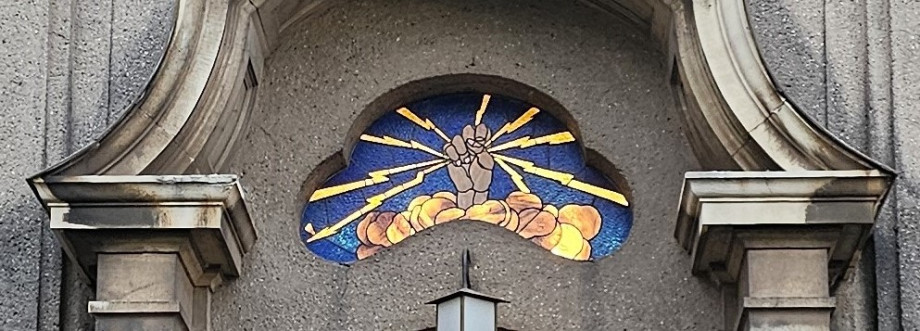Suzanne Ros, PhD Candidate at the University of Stavanger / Energy Lives Project, reflects on her experience of her summer residency at E-WERK, Luckenwalde, Germany.
Blog post
The blogpost is written by
What does it mean to become energy literate? How do we come to see, feel, and understand energy in our everyday lives—not just as abstract systems or numbers, but as something tactile, emotional, and embedded in histories and landscapes?
This summer, I spent ten days in Luckenwalde, a small town in Brandenburg just outside Berlin, for a residency at E-WERK—a former brown-coal power station that now runs as a regenerative energy site and contemporary art centre. The experience became a deeply embodied and immersive lesson in what it means to live among energy infrastructure, and to understand energy not just through theory, but through material encounters, conversations, and a lingering dust on my hands.
From carbon to “Kunststrom”
On arrival, I was struck by the former industry building itself—grotesque, proud, and heavy with history. Its massive turbine hall echoed with past vibrations of industrial life. The garden, filled with old parts of machinery, original coal used for the station while contemporary art installations of solar panels hinted at transformation. We, a group of PhD and MA students from various disciplinary and international backgrounds, were given a site tour by curator Helen Turner and artist Pablo Wendel who co-direct E-WERK with the vision to produce “Kunststrom” or “art power”—energy generated from woodchips to power and create an art centre.

Pablo recounted stories of the building’s former life. One tale involved a misplaced wrench that allegedly destroyed one of the turbines. But the fate of the old machinery remains uncertain—some say the turbines were shipped to Russia, others that they were dismantled for parts. These mysteries linger in the space, raising questions about memory, decay, and transition. Today, E-WERK runs on biomass, such as woodchips, and solar and wind power. It feeds electricity back to the national grid and simultaneously powers its own exhibitions and studios. It is, uniquely, both an art institution and a power station.
Energy is dust, heat, and memory
As a researcher working on geothermal energy, hot springs, and Indigenous land relations in Iceland and Aotearoa New Zealand, I often think about energy in relation to land, time, and extractivism. But this residency added new layers to my understanding.
One hot afternoon, I climbed a series of narrow ladders to the top of the woodchip processing plant. As I ascended, the temperature rose dramatically—residue from the chips was in the air and clung to the stairs. My hands were soon covered in dust. Pablo guided us carefully, pointing out the places where workers used to walk, check gauges, and maintain machinery. The heat, the smell, the texture of the dust—all of it made energy real. It was no longer abstract; it was affective, embodied.
Bucket conveyer for woodchips, captured by Suzanne Ros during the summer residency
I began to see how energy literacy is not just about reading a meter or knowing how a grid works—it’s about being attuned to energy’s traces and transformations. It is about understanding how energy infrastructures are lived spaces: places where human and non-human forces interact, where histories of labour, extraction, and care are inscribed in rusted staircases and creaking pipes.
Energy and community
Throughout the residency, we heard from former workers who remembered the rhythms and sounds of the turbine hall, the working conditions in GDR times and the heat of the engine room. Their stories were not necessarily nostalgic, but grounded in a knowledgeable, tangible relationship with the machinery. Their ties to the building remain strong, extending beyond the existence of the East German state —even as the building now functions very differently.
I saw how E-WERK tried to honour this connection. By using the electricity production for the contemporary art programme, it creates new forms of community. Many volunteers help organise exhibitions and events. Artworks respond to the site’s layered history. Energy, here, is not just economic—it is social, cultural, and affective.
Several elements of the “carbon form” are visible here. Architectural theorist Elise Iturbe argues that the “idea of carbon form allows objects and activities to be understood in relation to the larger sociospatial and energetic organizations that determine their formation, making visible their position in land-use patterns, economic and political relations, and specific configurations of built form.”1 At E-WERK, we could see carbon form persisting—but also being reworked. The building still carries the remnants of coal but is being used to be a prototype for a post-carbon future, one grounded in care, survival and creativity
Noticing energy differently
Energy literacy, then, emerged not through data or graphs, but through lingering sensations: dust on the hands, heat on the back, the sound of wind in a massive empty hall. It came through conversations with citizens of Luckenwalde, volunteers, and artists' work and through attention to the things that often go unnoticed—like the street of former workers’ houses across the road, a fieldtrip to the nearby forest, or the faint hum of generators.
To be energy literate is to notice energy in both its enormous and small forms. It’s to understand how power operates materially and socially, and to recognise our own entanglements with it. E-WERK is one of the few places I have visited where this becomes visible. It is a site where past and future forms of energy coexist, and where artistic and technical knowledge come together in surprising ways. As we move toward uncertain energy futures, we need more places like this—where we can not only think energy but feel it.
1. Elisa Iturbe, ‘Architecture And the Death of Carbon Modernity’, Log, no. 47 (2019): 14
Bibliography
Iturbe, Elise. ‘Architecture And the Death of Carbon Modernity’, Log, no. 47 (2019).